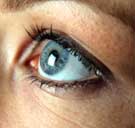Mounting evidence suggests that acupuncture is an effective treatment for retinitis pigmentosa (RP), a degenerative eye disorder that may to lead to blindness. A recent study published in the Journal of Clinical Acupuncture and Moxibustion concludes that acupuncture treatment protects the optic nerve from damage caused by intraocular pressure by alleviating stresses on retinal and optic nerve axonal ultrastructures.1 The Chinese Journal of Integrated Traditional and Western Medicine published that the use of Chinese medicine improved retinal cone activity for patients with retinitis pigmentosa, even in cases of advanced retinal degeneration. Using electroretinograms for the investigation, the study also concludes that, “TCM (Traditional Chinese Medicine) treatment could also enhance the bioactivity of (the) nerve network and therefore have a definite significance in retarding the progression of disease and keeping the central vision.”2 In another study, injections of She Xiang into acupuncture points UB18 and UB23 helped patients with retinitis pigmentosa. The study concludes that injection of She Xiang into Ganshu (UB18) and Shenshu (UB23) “can improve effectively the function and metabolism of optic cells, promote blood circulation of the retina, enhance the visual acuity, and protect the central vision for the patient of retinitis pigmentosa.”3 Yet another study of retinitis pigmentosa patients receiving acupuncture (ranging from ages 7 – 75 years) showed significant improvement and a halting of deterioration of the visual field.4
Acupuncturist Protocols
Acupuncture points generally include a combination of local and distal points to brighten the eyesight and to treat the patient’s underlying disharmonies per differential diagnosis. One study notes that retinitis pigmentosa patients with Spleen and Kidney Yang deficiency respond particularly well to Chinese Medicine.5 Although a genetic disorder, the progression of eyesight deterioration can be ameliorated by supplementation of the internal systems responsible for the homeostatic balancing of the retina.
Acupuncture Eyesight Point Selection
Local acupuncture points including St2, Yin Tang, Tai Yang, GB20, and Yu Yao are helpful in the treatment of retinitis pigmentosa. Distal points include GB37, SI6, and Liv3. Scalp acupuncture includes triple needling of Du24. LI11 is added for heat with inflammation and Sp10 is added for patients with blood stagnation. Tonification and sedation of the point selection varies according to the differential diagnosis. Often, the peaceful technique is employed in the application of local points in order to harmonize the flow of blood and fluid in the eye and to avoid overstimulation.

References:
1 Sun He , Zhang Hu. The Protective Effect of Acupuncture Treatment on Retinal and Optic Nerve Axonal Ultrastructure in Rabbit Eyes with Chronic Elevated IOP. Journal of Clinical Acupuncture and Moxibustion. 2010-05.
2 Wu Xing-Wei; Tang You-zhi. Study on Treatment of Retinitis Pigmentosa with Traditional Chinese Medicine by Flicker Electroretinogram. CHINESE JOURNAL OF INTEGRATED TRADITIONAL AND WESTERN MEDICINE. 1996-06.
3 Hao Xiaobo, Wang Guihong, Peng Changxin, et al. (Department of Ophthalmology, the First Affiliated Hospital of Guangxi University of TCM, Nanning 530023, China). Study on treatment of retinitis pigmentosa with acupoint injection of Shexiang Injection. Chinese Acupuncture and Moxibustion. 2003-4.
4 Reddy NS, Fouzdar NM. Role of acupuncture in the treatment of `Incurable' retinal diseases. Indian J Ophthalmol 1983;31:1043-6.
5 Wu Xing-Wei; Tang You-zhi. Study on Treatment of Retinitis Pigmentosa with Traditional Chinese Medicine by Flicker Electroretinogram. CHINESE JOURNAL OF INTEGRATED TRADITIONAL AND WESTERN MEDICINE. 1996-06.

